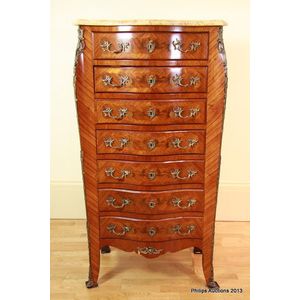18th Century Scandinavian Oak Chest with Baroque Design
You must be a subscriber, and be logged in to view price and dealer details.
Subscribe Now to view actual auction price for this item
When you subscribe, you have the option of setting the currency in which to display prices to $Au, $US, $NZ or Stg.
- Scallop / Shell Motif - The shell motif has been used in furniture and decorative arts for centuries. In ancient Greece and Rome, shells were often used as decorative elements on furniture and in mosaics. The scallop or cockleshell are the most commonly used. During the Renaissance, the shell motif became popular in furniture and architecture, as the ornate decoration was seen as a symbol of wealth and luxury. In the 18th century, the Rococo style of furniture and decorative arts featured an abundance of shell motifs, and it was used by Thomas Chippendale and as a feature on Queen Anne style cabriole legs. In the 19th century, the shell motif was incorporated into Victorian furniture and decorative items, and often a representation of the the conch shell was inlaid into furniture.
- Oak - Native to Europe and England, oak has been used for joinery, furniture and building since the beginning of the medieval civilisation. It is a pale yellow in colour when freshly cut and darkens with age to a mid brown colour.
Oak as a furniture timber was superceded by walnut in the 17th century, and in the 18th century by mahogany,
Semi-fossilised bog oak is black in colour, and is found in peat bogs where the trees have fallen and been preserved from decay by the bog. It is used for jewellery and small carved trinkets.
Pollard oak is taken from an oak that has been regularly pollarded, that is the upper branches have been removed at the top of the trunk, result that new branches would appear, and over time the top would become ball-like. . When harvested and sawn, the timber displays a continuous surface of knotty circles. The timber was scarce and expensive and was used in more expensive pieces of furniture in the Regency and Victorian periods. - Baroque Furniture - Baroque furniture is a style of furniture that was popular in Europe during the Baroque period, which spanned from the late 16th to the early 18th century. Baroque furniture is characterized by its ornate, decorative design, which often features elaborate carvings, gilding, and other embellishments.
Baroque furniture was popular in many European countries, including Italy, France, and Germany, and it was often used in the homes of the wealthy and in royal palaces. The Baroque style is also associated with the Church, and many churches and cathedrals from this period feature Baroque-style furniture and decorations.
The Baroque style of furniture is characterized by ornate and extravagant design elements that originated in Italy in the 17th century and spread to other parts of Europe, where it was particularly popular in the courts of royalty and the wealthy aristocracy. Baroque furniture is often made of rich materials such as gold, silver, and precious woods, and it is decorated with intricate carvings, inlaid designs, and gilded or painted finishes.
This item has been included into following indexes:
Visually similar items

Antique Regency mahogany bow front chest of drawers

Pair of English George III style serpentine front four drawer mahogany chests. Approx 80.5 cm high, 85 cm wide, 56.5 cm deep, (2)

A Louis XV style Semainier, of tapering serpentine form in walnut, kingwood and satinwood surmounted with a caramel marble top, with seven drawers each with stringing and floral inlay, foliate brass pulls, escutcheons, the sides with herringbone parquetry,

An old walnut small proportioned three drawer chest, with brushing slide above three full width drawers of graduated depths, the lower drawer with concave centre reflecting in the shaped apron raised on bracket feet, the drawers with crossbanding, brass ba
